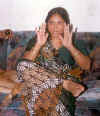| the-south-asian.com SEPTEMBER 2001 | ||
| about us contact us data bank past issues the craft shop the print gallery | ||
|
SEPTEMBER 2001 Contents Interview Heritage Cultural Heritage of south Asia People Communities Lifestyle Films Editor's Note
Books
|
Phoolan Devi by Roopa Bakshi Revenge has an on-going, endless script. Phoolan’s assassination may have been the end of a chapter but it is also the beginning of another. The issues and questions facing Phoolan were not specific to her alone. What are the choices and options for an underprivileged woman to defend her rights? Phoolan’s dilemma has been and will be the dilemma of many – the ethics of existence. Phoolan Devi was released from prison seven years ago. The Uttar Pradesh Government had dropped all charges against her. Theoretically she was ‘free’. But was she? Not really. Phoolan had asked for protection because she feared that the same elements that hounded her out of society, would loom into her horizon once again – and loom they did – and viciously too – by taking away her life last month in August. In these seven years Phoolan had re-charted her road map from ravines to Lutyen’s Delhi – as an elected member of the Parliament. A lunch break from the Parliament session cost Phoolan her life. At the time when Gloria Steinem and Germaine Greer were fighting for women’s rights and the world was high on Sartre’s Existentialism, a drama of existential death was beginning to unfold itself in a ravine village of Uttar Pradesh in India. It was business as usual in the village – with its class and caste prejudices. The main actors in the drama were the guardians of law, the offenders of law and a little girl, called Phoolan Devi, just about entering her teens, ill-equipped and socially handicapped to counter the wrath of either the ‘guardians’ or the ‘offenders’. Despite her economic and social limitations, Phoolan challenged an entire social order and bared the corruption of all those around her – especially the system that was engineered to preserve the dignity of mankind. She bared it by doing to the system, what the system had done to her – i.e violation – violation of her body, spirit and soul. L-R: Phoolan in her Chittaranjan Park home - cooking, with her dog Tiger, and praying to Goddess Durga. Phoolan surrendered and laid down her arms in 1983 before a picture of the Goddess Durga and a portrait of Mahatma Gandhi.(Photos: Jaydeb Saha) Described variously as the ‘Bandit Queen’, ‘female Heathcliff’, ‘female Robin Hood’ and many more sensational references, Phoolan Devi was an ordinary and a simple looking village woman who considered herself a ‘baghi’ – a rebel – fighting injustice. The parameters that Phoolan was born into, defined the eventual course of her life. Born into a poor Mallah family at the bottom-end of the caste heirarchy, she was one of six children in a family that owned just a patch of wasteland. A thumb impression on a piece of paper (in the custody of a greedy cousin), had robbed them of the little land that was rightfully theirs. The parents could ill-afford to educate or even look after their daughters. At the age of eleven, Phoolan was married of, to a man old enough to be her father, in exchange for a cow, a bicycle and a hundred rupees! Here she was, at the tender age of eleven, already a victim of circumstances (caste, poverty, politics of power, illiteracy, greed) and now choiceless and optionless. She saw her parents being framed and beaten up on false charges, saw their constant public degradation and humiliation. The perennial despair, the humiliation subjected by her husband and her eventual abduction by bandits was her ‘punishment’ – for defending her father’s land rights, for asking the law for protection and justice, for resisting sexual abuse. Phoolan was struggling in quick-sand – the more she struggled to get out of it, the deeper she went into it. At the bandit camp where she had been taken after her abduction, and later, she was subjected to repeated and brutal sexual assaults. This was the ultimate humiliation and vilation of her being. It left her emotionally mutilated and spiritually devastated – but determined to avenge her shame and that of her family’s. Phoolan’s struggle for her survival seemed too insignificant and trivial in the madness that had gripped the world at large in the 70s. But she rose, gun inhand, joining ranks with some of her abductors – and the bubble burst. She unleashed a torrent of hatred and revenge against her tormentors and violators. She looted and plundered, and distributed a large amount of the spoils among the needy. She was held responsible for hijacks, killings and massacres. In her quest ‘to seek justice’ Phoolan recognised no limits and defined no boundaries. It was the frenzy of a wronged woman who was out to exorcize society. Her rampage against the social order or rather ‘disorder’ continued until February 1983, when she surrendered on her terms and laid down her arms – not before living mortals – but before the Goddess Durga and a portrait of Mahatma Gandhi. She was released from prison in 1994 on medical grounds (she had been suffering from severe gynaecological problems as a result of repeated and brutal sexual violations). Idolized by some and condemned by others, Phoolan generated a stream of eclectic emotions and opinions among people – shock, sympathy, criticism, and at times compassion. The story of Phoolan’s life, and now death, has raised questions and kindled debates over the status of woman, especially the underprivileged woman, in society – a status that has to be redefined. How and what should be defined as the threshold of suffering. At what point should a human being cry out ‘Enough’! The press in the subcontinent still carries stories of kitchen and stove deaths and physical and psychological mutilation of women. Blatant or subtle, domestic violence is almost an accepted fact. But if provoked beyond a limit and pushed against the wall, there is a mute Phoolan lurking within most humans, who may just rise and ask ‘Why me?" The increasing incidence of stress and mental illness among women is a silent message to those around them. Phoolan was neither an icon nor a role-model – exploited in life and in death, she was a cursor that pointed the failings of our system and establishment – because in the final analysis, the culture and civilisation of a society is judged by the care it accords its weak and underprivileged. By this definition it is a long march to civilisation for our societies.
____________________
Copyright © 2000 - 2001 [the-south-asian.com]. Intellectual Property. All rights reserved. |
|



